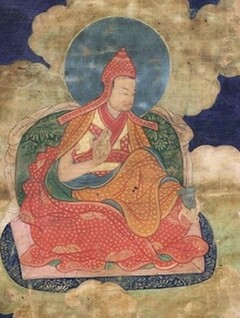Biography of Tāranātha
A Brief Biography of Tāranātha
by Alak Zenkar Rinpoche
Jonang Jetsün Kunga Nyingpo, or Lord Tāranātha as he is generally known, was born in Chökhor Ding on the eighth day of the sixth month of the Wood Pig year of the tenth calendrical cycle (1575). His father was Namgyal Puntsok, a descendant of Ra Lotsawa, and his mother was Dorje Buga Lhamo. As soon as the child was born his grandfather gave him the name Pema Sichö Dorje.
When the boy was in his fourth year, he was invited by Khen Lungrik Gyatso, at the behest of the governor of Nakartsé, and enthroned at Chölung Jangtsé as the incarnation of Lama Kunga Drolchok.[1] Once there he learned to read and write all by himself even without the aid of a tutor. In his eighth year, he took ordination from Taklungpa Kunga Gyaltsen and received the name Kunga Nyingpo Tashi Gyaltsen. (The name Tāranātha was bestowed in a vision by the emanated Indian guide Jvālanātha.)
With the supremely learned Jampa Lhundrup, he studied several works related to sūtra and tantra. He also received empowerments and instructions for numerous cycles of Sakya teaching, especially the Path with Its Fruit (lam ’bras) from the great Lord Doringpa. From the sublime Draktöpa Chöku Lhawang Drakpa, he received various instructions, especially on Mahāmudrā. Khen Lungrik Gyatso granted him the actual transmission and blessings of the Six-branch Yoga, including empowerments and instructions for the glorious Kālacakra. He also received the transmission for a great many texts among the Buddha’s words and the treatises. From Khedrup Sangye Yeshe, Yeshe Wangpo and other teachers, he received empowerments and instructions related to multiple dharma cycles from various traditions including the Jonang, Shangpa, Zhalu, Drukpa, Kamtsang, and Taklung.
In his twentieth year, he was fully ordained before a gathering of the requisite number that included the vinaya-holder Kunga Gyaltsen as preceptor.
From the great Indian adept Buddhaguptanātha, he received countless tantric empowerments and instructions on the generation and perfection phases. The master himself said that this produced as many as five hundred new notions related to works of unsurpassable mantra previously unknown here in Tibet. He also received many profound dharma teachings from the Indian masters Nirvāṇaśrī, Pūrṇavajra and others. Through this and through studying Sanskrit grammar and all the infinite outer and inner sciences, he reached the very pinnacle of learning. By training in the crucial points of practice related to both sūtra and mantra, he realized all the qualities of the stages and paths and became a lord among yogis.
In his twenty-first year, he took his seat at the Jonang hermitage. There he established the tradition of the Great Kālacakra Exposition and gave extensive instructions. In his twenty-sixth year he travelled to Radreng and elsewhere. When he saw the Indian texts, his confident assurance was so great that he expounded the Black Enemy Yamāntaka tantra in two languages with remarkable force and speed. Everyone present was amazed and offered words of praise.
In his forty-first year, the ruler of Tsang, Puntsok Namgyal, offered him land and workers, and through these auspicious conditions he established Takten Damchö Ling Ngedön Gawé Tsal (Joyful Grove of the Definitive Meaning, Sanctuary of Sublime Eternal and Steadfast Dharma).
In these and other ways he was unparalleled in his service to the teachings through explanation, practice and activity.
Finally, in his sixty-first year, on the twenty-eighth day of the third Tibetan month of the Wood Pig year, he relinquished the constituents of life and travelled to the realm of the King of Physicians.
Among the master’s principal students who continued his activities were various holders of the Jonang lineage, including Tulku Sangye Gyatso, the learned scholar Yeshe Gyatso, the great abbot Rinchen Gyatso, and the learned and accomplished Lodrö Namgyal. His disciples also included the Tsang ruler Puntsok Namgyal and his son, as well as Changdak Tashi Tobgyal, and many other rulers and patrons who strongly supported the teachings.
The sublime master’s collected compositions include A Hundred Deeds of the Buddha, A History of the Dharma in India,[2] the biographies of several scholars and adepts,[3] commentaries on the Heart Sūtra,[4] Prayer of Good Actions, and other texts, explanations of the generation and perfection practices for the Kālacakra, Saṃvara and Guhyasamāja tantras, and many other commentarial works related to sūtra and mantra. In particular, he wrote works such as The Extensive Madhyamaka of the Supreme Vehicle that set out the view of extrinsic emptiness (gzhan stong). He also composed several tantric rites as well as praises, prayers of aspiration, and more. In total, he wrote more than forty volumes, comprehensively and unerringly illuminating the view of sūtra and mantra in general and the Jonangpa tradition of the great Madhyamaka of definitive meaning in particular. He extended the transmission of Six-branch Yoga and raised aloft the victory banner of the teachings of the practice lineage.
Written by Tudeng Nima.
| Translated by Adam Pearcey, 2019.
Bibliography
Tibetan Edition
Thub bstan nyi ma. "Tā ra nā tha'i rnam thar rags bsdus" in Tā ra nā tha. rGya gar chos 'byung. BDRC W12434. 1 vol. Chengdu: Si khron mi rigs dpe skrun khang, 1994: 1–5
Secondary Sources
Mi nyag mgon po (et al.). "rJe btsun tā ra nā tha'i rnam thar mdor bsdus" In Gangs can mkhas dbang rim byon gyi rnam thar mdor bsdus, 2 vols. Beijing: Krung go'i bod kyi shes rig dpe skrun khang. 1996–2000. Vol. 1: 322–332.
Stearns, Cyrus. "Tāranātha," Treasury of Lives, accessed February 04, 2019, http://treasuryoflives.org/biographies/view/Taranata/2712.
Version: 1.3-20220830
-
Kun dga’ grol mchog, 1507–1565. ↩
-
See Lama Chimpa and Alaka Chattopadhyaya (trans.). Tāranātha's History of Buddhism in India. Delhi: Motilal Barnasidass, 1970. ↩
-
See, for example, Templeman, David. Tāranātha's Life of Kṛṣṇācārya/Kaṇha, Dharamsala: Library of Tibetan Works and Archives, 1989 ↩
-
See Tomlin, Adele. Tāranātha's Commentary on the Heart Sūtra: A Study, Translation and Critical Edition. Dharamsala: Library of Tibetan Works and Archives, 2017 ↩
